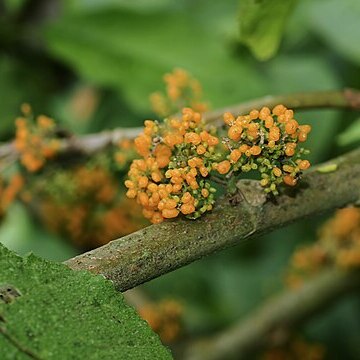Trees or shrubs, rarely scandent, usually with stinging hairs or stout prickles; stipules free, or more or less connate; leaves alternate, petiolate, 3-or 5-nerved at base, penninerved above, the cystoliths punctiform, linear, or wanting; plants usually dioccious, the flowers in axillary, dichotomous or irregularly branched cymes or panicles; staminate flowers with a 4-5-parted perianth and 4-5 stamens and a rudimentary ovary; pistillate flowers with 4 equal or unequal segments, the stigma penicillate-capitate, persistent; achenes straight or oblique, at least partially sur-rounded by the fleshy, enlarged perianth.
Tree(lets) shrubs or subshrubs, usually dioecious, (usually) with stinging hairs or prickles. Leaves in spirals (to distichous); stipules connate; blade pinnately veined. Inflorescences paniculate, dichotomously or more or less irregularly branched, with the flowers solitary or in glomerules; flowers pedicellate or sessile. Staminate flowers with 4-5, basally connate tepals; stamens 4-5. Pistillate flowers with 4, equal or unequal, basally connate tepals; stigma penicillate-capitate, persistent on the hooked apex of the fruit. Achene partly enveloped by a slightly enlarged, juicy perianth.
Dioecious woody climbers, or lianas often reaching the top of the supporting tree, mostly fixed to the substrate by adventitious, axillary roots from the stems; stinging hairs on the herbaceous parts or at least a few on the petioles and inflorescences, rarely totally absent, frequently mounted on epidermal protuberances.
Female flowers with 4 somewhat unequal tepals ± free or fused for at least three quarters of their length; staminodes absent; ovary ovoid; stigma almost sessile, penicillate.
Fruit an achene, enclosed by the persistent perianth which increases in size and becomes fleshy and orange-yellow or red in fruit.
Leaves alternate, petiolate; lamina simple, with an entire to dentate margin, triplinerved.
Male flowers 4–5-merous, stamens equalling the tepals in number; ovary rudimentary.
Stipules fused for half to two thirds of their length, intrapetiolar.
Inflorescences axillary, paniculate cymes.
Cystoliths dot-like.

